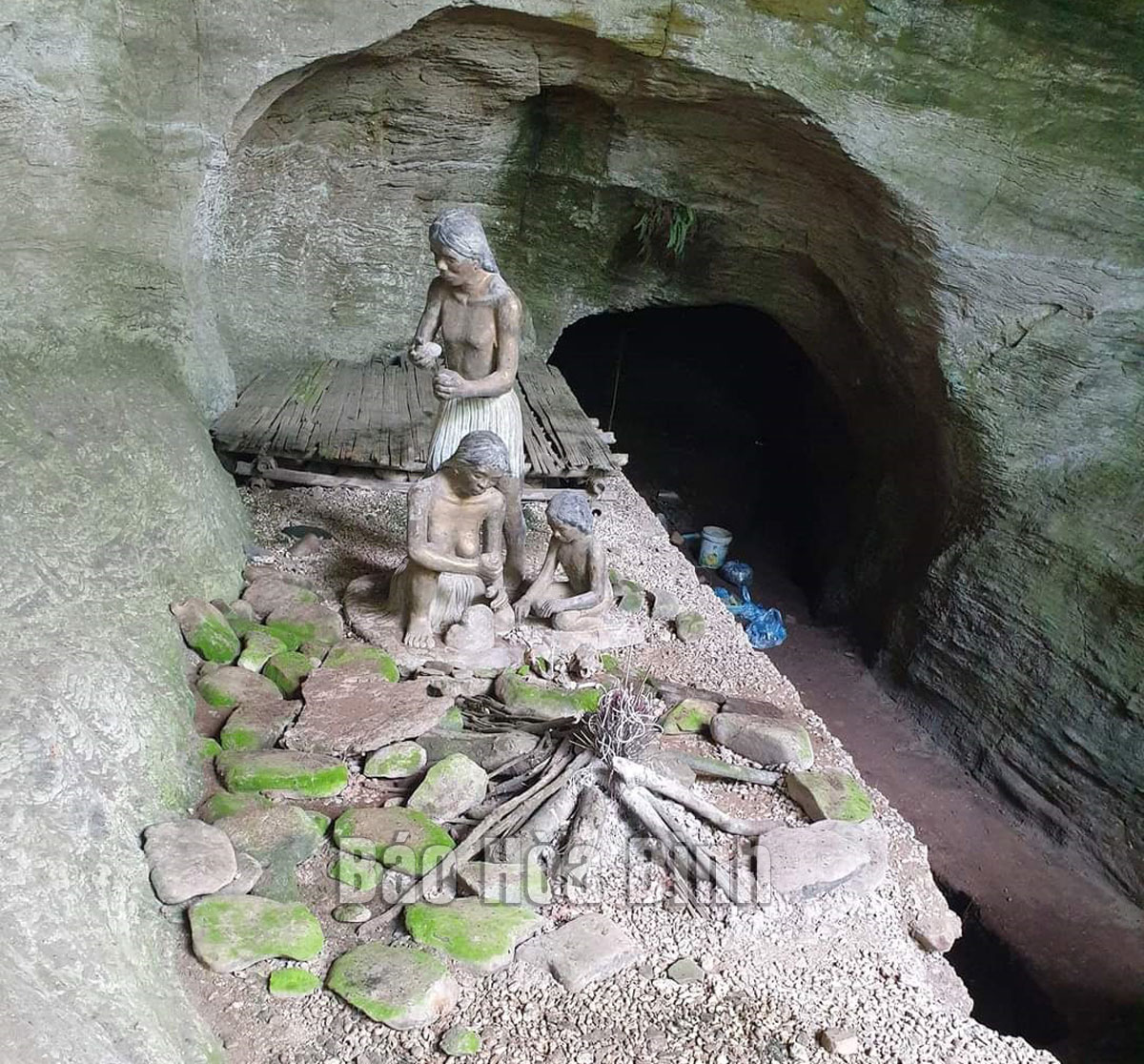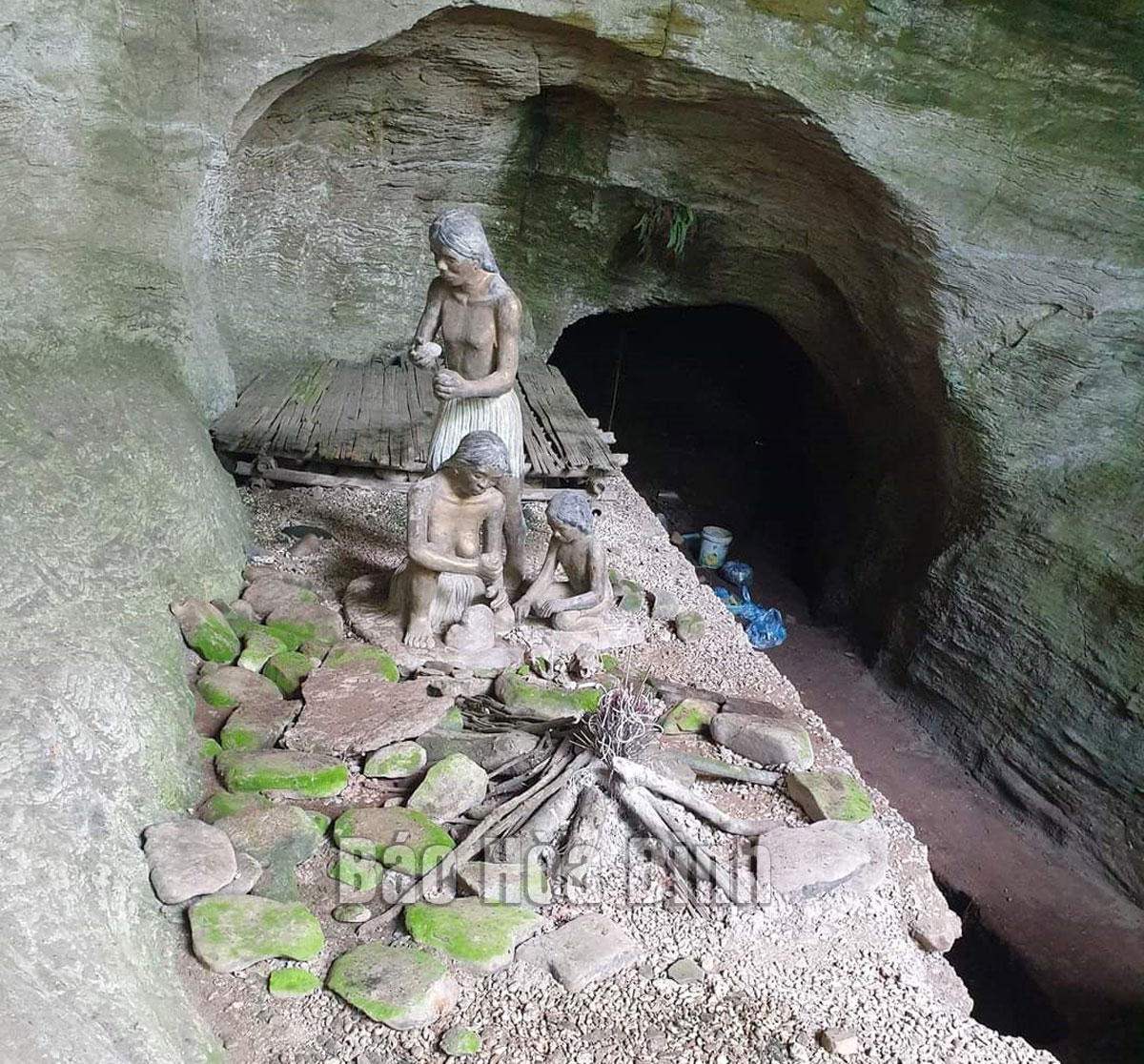
(HBO) – The Hoa Binh Civilisation, dating back to the Stone Age, was discovered by French archaeologist Madeleine Colani and named after the cave relics found in the karst areas of Hoa Binh province. In Vietnam, its traces have been unearthed mostly in Hoa Binh and Thanh Hoa provinces (over 80% of the total relics), while the rest scatter in the provinces of Thai Nguyen, Lai Chau, Son La, Ninh Binh, Ha Nam, Nghe An, Ha Tinh, Quang Ninh, Quang Binh, Quang Tri, and some others. Not only in Vietnam, this civilisation also existed across the mainland Southeast Asia, from southern China to Sumatra Island of Indonesia, Myanmar, and the Philippines.
A demonstration of the life of primitive humans at Xom
Trai Cave in Tan Lap commune, Lac Son district.
The reason for the concentration of Hoa Binh
Civilisation relics in Hoa Binh and Thanh Hoa is that local karst areas had
stable and consistent geological features, and they were also located in the
transition zone of the northern, western and southern geological regions. That
blessed the two provinces with diverse and complex natural conditions as well
as creature richness, resulting in food abundance.
Caves and rock shelters of the Hoa Binh
Civilisation were located at about 15 - 20 metres above the valley’s bed. The
residential space of people at that time varied according to relic sites. Some
caves and shelters are 10 square metres wide while others cover thousands of
square metres, but most have an area of 50 - 150 square metres. Those places
were also lit and warmed by sunlight in the morning. More than 90% of those
sites could keep their inhabitants from cold northwest winds in winter.
Late Professor Tran Quoc Vuong highly valued the
residential locations of the Hoa Binh Civilisation people, saying those places
were the prerequisite for primitive humans to develop agriculture and move to
lowland areas to develop a new civilisation.
Archaeological documents and excavations showed
that hunting and foraging were the main ways of subsistence of people of this
civilisation. Those activities mainly took place in valleys.
Working tools in the Hoa Binh Civilisation were
made from wood, bamboo and pebble. When finding places to reside in, apart from
choosing the sites with necessary natural conditions like sunlight, rivers, and
streams, people at that time also paid special attention to those near pebble
and limestone sources to make working tools.
Archaeological findings also revealed that women
played the main role in creating working tools while men were in charge of
hunting. Women also hunted small animals and mollusk, and picked vegetables and
fruit, which were not as hard as men’s work but generated high economic value.
Women were also responsible for bringing up children, sustaining fire, cooking,
and storing food. Therefore, women’s role gradually became important and
indispensable in each cave of primitive humans.
Ninety years have passed since the discovery of
the Hoa Binh Civilisation, but there remain a number of questions waiting for
answers about this civilisation before a panorama of the society in that period
could take shape./.
The clothing of women reflects the culture of the Muong, Thai, Tay, Dao, and Mong ethnic groups in the northern province of Hoa Binh.
Gongs hold a special place in the cultural and spiritual life of the Muong ethnic people in Hoa Binh province. More than musical instruments, they are an indispensable part of community rituals and collective memory, echoing through generations as a spiritual thread linking the past, present, and future.
Preserving and promoting the cultural values of the Muong ethnic group has become an urgent task in the current context, as many traditional values face the risk of fading away. This effort requires not only protecting the cultural identity but also eliminating outdated customs and developing a modern cultural lifestyle, contributing to sustainable values for the Muong community in Hoa Binh province.
The Muong ethnic culture, deeply rooted in Vietnam’s mountainous north, continues to be preserved and revitalised by dedicated individuals and communities determined to safeguard their ancestral identity.
The Muong group is one of the largest ethnic minorities in Vietnam, primarily found in Hoa Binh province. The Muong people in Hoa Binh boast a rich and diverse cultural treasure that reflects the unique identity of this ethnic group. Accounting for over 63% of the province's population, they have created and preserved numerous distinctive cultural values, contributing to their unique identity. Their cultural heritage is an invaluable asset, at the heart of their national identity, and represents a vibrant spiritual life that must be preserved and promoted in today’s modern world.
For generations, the ethnic communities of Hoa Binh province, particularly the Muong people, have preserved vibrant festivals deeply intertwined with the region’s geography, nature, and social traditions. These celebrations enrich Hoa Binh’s spiritual life and cultural identity, reflecting both folk beliefs and the intermingling of ethnic customs. Many of these festivals have endured the test of time, passed down through generations and continuing to thrive today. Among them, the Khai Ha (Going Down to the Field) festival stands out as one of the most significant events of the Muong ethnic group.



